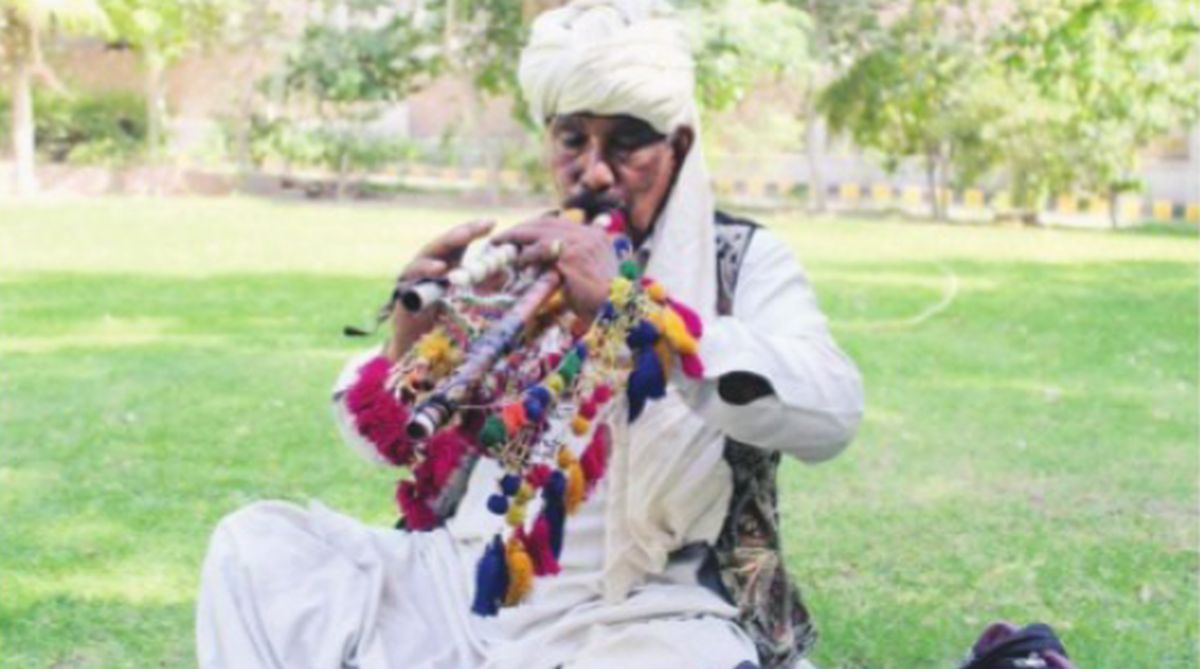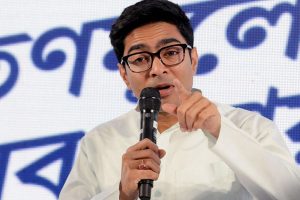‘The alghoza sounds like war, peace, forests, seasons, the weather, mountains, seas and the sounds of nature,” says Ustad Ameer Ali Khan, a renowned connoisseur of Sindhi music. “When one hears it being played, it brings to mind the imagery of Sindhi villages, a panorama of flat landscapes and the rural life of Sindh. You unintentionally start to create a picture of a herd of cattle and goats and sheep mooing and bleating in the fields.”
“I see a surreal Sindh dancing to its tune before my eyes when I listen to the alghoza,” says 47-year-old Fateh Muhammad. “Clouds rumbling with distant thunder over Thar, Laar, Kaacho and Utar, conical huts and the flora and fauna of Sindh begin to loom large. To me, it is the music of ecstasy.”
Alghozais a wind instrument, which consists of two flute-shaped recorders; one of them produces high or heavy notes (sopranos) whereas the second generates thin or low notes (altos). Normally, the alghoza-nawaz (alghoza player) and music experts call the former a female sound and the latter a male sound.
Advertisement
The male sound or note continuously keeps playing with the same pitch without any gap, while the female sound or note fluctuates, varying in pitch. The male flute, with a fat nib at the top, is 2.5 feet long and the female flute, with a slender nib, is 1.5 feet in length. Each flute has six holes. The instrument is usually adorned with the traditional fancy flounces and frills of beads and threads.
Two types of woods are used in the preparation of an alghoza. The kirar(Capparis decidua) wood is used for the flute producing low notes, and taalhi (Dalbergia Sissoo) wood is for the one producing high notes. A nib or a reed is attached at the top of each flute with beeswax, which works as gum. The beeswax is heated and the reed or nib is dipped into it and then fixed on to the top of the flute. It is then left to dry under the sun till it congeals to hold the reed and the flute together.
The origins of the alghozaare unclear. Some say it originated in Iran and descended, with some modifications, to Balochistan and then to Sindh. Others claim it has Punjabi origins. Contrary to these opinions, according to research conducted by professor Zulifqar Ali Qureshi —the only Sindhi to hold a PhD in musicology — the alghoza is 9,500 years old.
According to a PhD thesis by Malhaar, The History of Alghoza, it originated in Mesopotamia, Egypt, snaking down into Persia, Sindh and Rajasthan after modifications. Some Mesopotamian archaic paintings contain a musical instrument with twin recorders similar to an alghoza.
Qureshi, who is associate professor at University of Sindh Jamshoro, says, “Actually, it was named as Al-joza (with ‘j’ sound not the ‘gh’ sound) in early times in Mesopotamia but the name was modified as it reached local areas, like Balochistan and Sindh. It began to be called as alghoza (and) written with ‘gh’ and pronounced with the ‘ghaen’ sound.”
In old times, grazers played it while their animals grazed. It would not only help them while away the time they spent herding their flocks of sheep or cattle, but unlike the flute —whose notes are commonly perceived to connote sad, melancholy music — the alghoza’s music represents happiness.
It is believed that, initially, the alghoza would be played in the wild moorlands, and was popularised in Sindh by the blind Shah Muhammad. He was discovered by Nabi Bakhsh Khan Baloch of Mirpur, Bathoro, before Partition. Khameeso Khan Jhinjhi — a protégé of the great alghoza-nawaz Shah Muhammad “nabeena” — Misri Khan Jamali, Allah Bachayo Khoso, Abdul Karim Gopang and Uris Faqir are among those who earned great admiration and respect in Sindh for their skilful playing.
Jhinjhi, a soloist, was the first in Sindh to come up with the idea of playing the tunes of Sindhi songs on alghoza, which was a breakthrough in Sindhi music, as previously it was believed that Sindhi melodies could not be set to the tune of the alghoza.
A few famous Sindhi songs that have been played on the alghoza are Peren pavandisaan, Chavandisaan, the ever popular folk song Yaar daadi ishq aatish aai-hai, Muhanja sain sindhi topi wara —sung by the highly-regarded playback singer from the 1960s and 1970s Runa Laila — and Sindhri-a te sir ker na dendo. Also some surs (chapters) from Shah Abdul Latif Bhittai’s Risalo (an anthology), such as Sur Kohiyari, Sur Raano and Sur Kalyaan have been composed for the alghoza.
“In Sindh, it is believed that alghoza played on two surs (notes), namely kohiyari and raano, delights people the most,” says Naseer Mirza, an authority on Sindhi musicology. Unfortunately, unlike in developed countries, there is still a hereditary system in music, in singing and playing instruments, which means few from outside the established musician families can break into the field.
Khameeso Khan’s two sons play the alghoza because it is what their father did. There are no new entrants as the youth is also not keenly inclined to follow traditional art forms.
Weenhoo Mal, an expert alghoza player, feels that the reason young people do not learn to play the instrument comes down to economics — it won’t fetch them the kind of money and work playing a guitar would do, so they are not interested in it. Mal has visited three countries on a Sindh government programme as an alghoza player and was delighted to receive monetary returns and applause. In his eyes, however, the greatest appreciation is when he is gifted with the traditional ajrak (shawl) and patka (turban), as a mark of respect for playing.
“It took more than 10 years to learn. Here people don’t value an artist but in the UK, music experts have an appreciation for the alghoza; they were astonished to see how I breathed while playing it.” For producing melodious and catchy tunes, a balanced manoeuvring of blowing the air out is required. Breath control that comes with endless discipline and exercise is required to become an alghoza maestro.
“I told my sons that I had never thought I would ever board an aeroplane but it was because of the alghoza that I went abroad. Alas, even my sons do not realise its true worth and have decided not to learn it,” says Mal sadly.
Interestingly, locals believe that since the music of alghoza has varying beats and irregular rhythms — known as lehrun waro in vernacular —it possibly exorcises evil spirits and phantoms. “I don’t know whether it drives out evil ghosts and devils, but it certainly takes away my fatigue and gives me peace and relaxation,” explains Anwar Ali, an elderly man who had come to a village fair near Tando Mohammad Khan to listen to an alghoza player.
“Almost all the skilled alghoza-nawaz are like members of my family,” says Mirza. “They have never been well-off yet they continue to play the instrument for the love of it.”
“Alghoza playing is a dying art like so many other art forms. At the same time, with some innovation, it can still be turned into a matchless musical instrument and saved,” says Qureshi. “It is up to the Culture, Tourism and Antiquities Ministry to devise a plan for institutionalising this art, by establishing musical schools and departments in colleges and universities and by engaging all alghoza-nawaz as teachers to pass on their knowledge to the young generations. This is the only way that the alghozaand its players can thrive.”
The writer is a social worker and journalist.
Dawn/ANN
Advertisement











